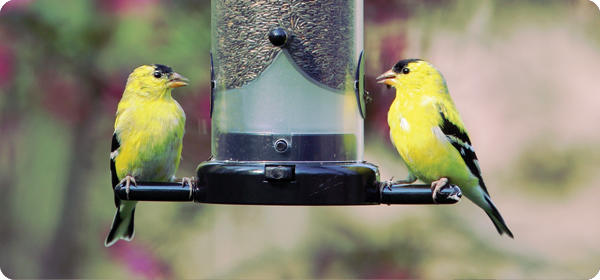
Attract Goldfinches to Your Backyard
Goldfinches live throughout the United States and southern Canada, a fact that makes attracting them to your backyard a bit easier. Though goldfinches carry the reputation of being finicky eaters, you’ll have no problem finding a suitable offering that will please their palate. Goldfinches love to eat fresh, dry Nyjer® (thistle) and sunflower seeds. Our Finch Blend is a combination of their two favorites.
Unlike many birds, goldfinches molt their body feathers twice a year: in the spring before breeding and after nesting in the fall. Females are a soft olive green and subdued yellow. Males sport vibrant, yellow coats with black wings, caps and tails during breeding season, but in the fall, they molt into duller colors that resemble the female.
The color of the legs, feet and bill of an American Goldfinch change with each feather molt. For breeding season, their legs, feet and bill are a buffy, yellow-orange color. During fall and winter, their legs, feet and bill are dark grayish-brown. During their fall feather molting, American Goldfinches grow a new set of feathers that are much denser than their summer plumage. These soft feathers provide an additional layer of insulation to help keep them warm throughout the winter.
The spring molt requires a large amount of nutrients and energy which probably diminishes their ability to nest earlier in the season. In July and August, after the male has serenaded the female with canary-like songs, goldfinches begin to nest for the first and only time of the year. The female American Goldfinch chooses the nest site, builds the nest and incubates the eggs all on her own. The male feeds the female on the nest throughout incubation and takes on an ever increasing role in feeding the nestlings as they grow older.
American Goldfinch can weave their nest so tightly that it will temporarily hold water.
American Goldfinch attach their nest to supporting twigs with spider web.
American Goldfinches prefer to nest in habitats with trees and shrubs and usually place their nest 4-10 feet high, often near a water source. They will sometimes nest in a loose colony.
Goldfinches usually lay 5 pale-blue or greenish-blue eggs that will hatch in about 12 days. Nestlings will fledge about 12 days after that.
While most Brown-headed Cowbird eggs fool the female American Goldfinch and are incubated to hatching, few cowbird chicks live longer than three or four days. This is due to the low amounts of protein found in the vegetarian diet of the goldfinch.
Young American Goldfinch are dependent on their parents for at least three weeks after fledging. Be sure to watch and listen for their energetic begging as they harass their parents for food at your feeders.
Goldfinches diet consists primarily of seeds. Native plants they prefer to eat include asters, coneflowers, sunflowers, and thistles. Thistles, milkweed, dandelions and cattails also provide fluffy nest building material. If planting thistle be sure to plant non invasive native types. You can find a list of noxious and invasive plants here.
Here are a few items to remember when attracting finches:
- Keep food fresh and dry inside the feeder. Shake the feeder periodically to make sure that the food is dry, and use a Weather Guard to help protect your food from the elements. Make sure the food does not stay in the feeder uneaten for more than three to four weeks. Rain? Moisture? No problem with Feeder Fresh™, a bird-safe additive that protects your seed and feeders from mess and mold. This helps keep your birds healthier and your feeders clearer. Use a long handled brush to clean out your feeders.
- Nyjer has a lot of protein and fat that is needed for growing their feathers. Be prepared for increased activity at your feeders in the spring and fall, when goldfinches are molting.
- Once they've fledged, young goldfinches still depend on their parents for food. Watch for these juveniles at your feeders as they beg for food from their parents.
- Due to their almost exclusive diet of seeds, goldfinches drink frequently and will stay close to reliable sources of water during dry periods. Use a bird bath and keep the water clean and fresh.
Visit the store or call us if you have any additional questions about attracting goldfinches to your yard.

